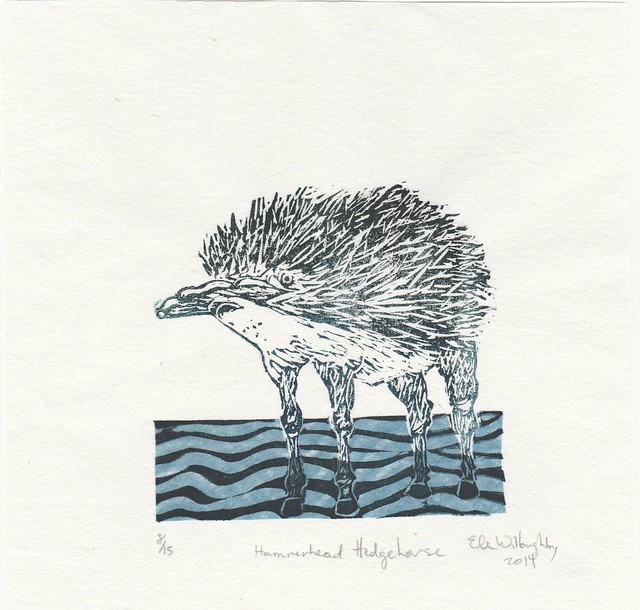 |
| Hammerhead Hedgehorse, by Ele Willoughby, 2014, Linocut mini print (printed area 10 cm x 10 cm or 4" x 4", on 18 cm by 18 cm sheet of Japanese kozo paper with chine collé blue Japanese tissue) |
Some believe that the hammerhead hedgehorse is imaginary. Who am I to say?
Though it appears to be an extraordinarily tall hedgehog, with hoof-like feet and uncanny peripheral vision, the hammerhead hedgehorse is not closely related to the hedgehog. Its nearest neighbour, genetically speaking, is the pygmy hippo. They may appear to have horse-like hooves, but they do in fact have four toes and are hence even-toed ungulates, like the hippo family. Over the millenia, the taller proto-hedgehorses proved more successful at scanning the rivers for predators. Likewise, through the process of natural selection, those animals with increasingly shorter, wider snouts and greater peripheral vision afforded by wider spaced eyes, were better able to spot and escape predators and hence more likely to pass on their genes. Their name, in fact, is inspired by their unlikely ressemblance to the hammerhead shark - also, not a close relative. The hammerhead hedgehorse is a semi-aquatic mammal, not a fish, despite the well-known folktale about the fisherman and the bag of hammerhead hedgehorses. It is believed that the folktale is the source of the collective noun for these animals: "a bag" and the expression "as crazy as a bag of hammerhead hedgehorses".
Adult males can grow to 15 cm in height (or 6 inches) and females are somewhat smaller at 14 cm (or 15.5 inches). They are covered in spines made of keratin, much like a hedgehog and can vary in colour from blue-greens to brown.
_________________________________________
In other news, the pop-up sale at Hunt Club in Little Italy has been post-poned until further notice. I'll let you know when they have an opportunity to reschedule.









No comments:
Post a Comment